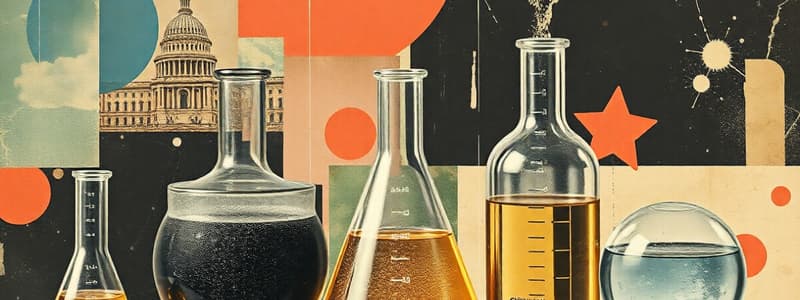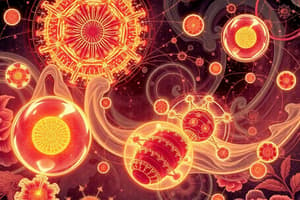Podcast
Questions and Answers
How does an increase in temperature affect solid substances?
How does an increase in temperature affect solid substances?
- They expand to some extent. (correct)
- They push particles closer together.
- They contract minimally.
- They expand to a greater extent.
What happens to the volume of a solid when it melts into a liquid?
What happens to the volume of a solid when it melts into a liquid?
- It evaporates rather than melting.
- It compresses to a smaller volume.
- It remains unchanged in volume.
- It usually expands to fill a slightly larger volume. (correct)
What characteristic of gas particles affects their behavior in a contained space?
What characteristic of gas particles affects their behavior in a contained space?
- They have strong attractions between them.
- They occupy a fixed volume.
- They move freely and collide with each other. (correct)
- They are tightly packed.
Which statement is true about the composition of matter?
Which statement is true about the composition of matter?
What proportion of total volume do gas particles typically occupy in the air?
What proportion of total volume do gas particles typically occupy in the air?
Why can liquids flow and take the shape of their container?
Why can liquids flow and take the shape of their container?
What does the term 'compound' refer to in chemistry?
What does the term 'compound' refer to in chemistry?
How do the particle arrangements in gases differ from those in liquids?
How do the particle arrangements in gases differ from those in liquids?
What distinguishes a substance from a mixture?
What distinguishes a substance from a mixture?
Which of the following best describes an atom?
Which of the following best describes an atom?
What is the net charge of a neutral atom?
What is the net charge of a neutral atom?
Which statement about protons and electrons in an atom is true?
Which statement about protons and electrons in an atom is true?
Which of the following is an example of a mixture?
Which of the following is an example of a mixture?
What components make up the nucleus of an atom?
What components make up the nucleus of an atom?
How does the presence of electrons contribute to the charge of an atom?
How does the presence of electrons contribute to the charge of an atom?
What is responsible for the majority of an atom's mass?
What is responsible for the majority of an atom's mass?
What defines the atomic number of an element?
What defines the atomic number of an element?
Which statement is true regarding isotopes?
Which statement is true regarding isotopes?
If a carbon atom has an atomic number of 6 and a mass number of 14, how many neutrons does it contain?
If a carbon atom has an atomic number of 6 and a mass number of 14, how many neutrons does it contain?
Which of the following represents a laboratory-created isotope of carbon?
Which of the following represents a laboratory-created isotope of carbon?
What is the primary similarity between all isotopes of an element?
What is the primary similarity between all isotopes of an element?
What property distinguishes solids from liquids and gases?
What property distinguishes solids from liquids and gases?
What happens to the motion of particles in a solid when it is heated?
What happens to the motion of particles in a solid when it is heated?
Which of the following statements about matter is correct?
Which of the following statements about matter is correct?
Why might some books from centuries ago be in better shape than newer books?
Why might some books from centuries ago be in better shape than newer books?
What effect does temperature have on particle motion?
What effect does temperature have on particle motion?
What is the relationship between the motion of particles and the state of matter?
What is the relationship between the motion of particles and the state of matter?
How can chemists answer questions about the effects of substances in everyday life?
How can chemists answer questions about the effects of substances in everyday life?
Which state of matter is characterized by particles that are in constant motion yet remain close to one another?
Which state of matter is characterized by particles that are in constant motion yet remain close to one another?
Flashcards are hidden until you start studying
Study Notes
Introduction to Chemistry
-
Chemistry is the study of matter and its properties, including the changes it undergoes and the energy associated with those changes.
-
Matter is everything in the universe that has mass and volume.
-
All matter is composed of tiny particles in constant motion.
-
Temperature influences the amount of motion in the particles.
States of Matter
-
Solids have particles closely packed together with strong attractions between them, resulting in limited mobility.
-
Liquids have particles closer together than in a gas, but more space between than in a solid.
-
Gases have particles far apart with negligible attractions. The particles move freely in a straight line until colliding with other particles.
Types of Matter
-
Elements are the simplest type of matter, composed of only one kind of atom. They have unique properties and cannot be broken down into simpler substances.
-
Compounds are formed when two or more different elements chemically bond together. They have properties different from their component elements and a fixed composition.
-
Mixtures are a combination of two or more substances (elements and/or compounds) physically bound together. Their compositions are not fixed.
Atoms
-
The smallest unit of an element is an atom.
-
An atom is spherical, consisting of a positively charged nucleus surrounded by negatively charged electrons.
-
The nucleus contains protons (positively charged) and neutrons (no charge).
-
The number of protons in the nucleus determines the element's atomic number.
-
The mass number is the total number of protons and neutrons.
-
Atoms are electrically neutral because the number of protons equals the number of electrons.
Atomic Structure
-
Electrons move rapidly around the nucleus, attracted to it.
-
The nucleus is incredibly dense, comprising the vast majority of the atom's mass.
-
Hydrogen (H) is the smallest atom, containing one proton and one electron.
-
Carbon (C) contains six protons, six neutrons, and six electrons.
Isotopes
-
Isotopes are atoms of the same element that have different numbers of neutrons and therefore different mass numbers.
-
All isotopes of an element have similar chemical properties despite their mass differences.
-
Carbon has three naturally occurring isotopes: 12C, 13C, and 14C.
-
Five other carbon isotopes (9C, 10C, 11C, 15C, and 16C) have been created in laboratories.
Studying That Suits You
Use AI to generate personalized quizzes and flashcards to suit your learning preferences.




